In July 1939, war looked inevitable and preparations were being made to protect the public from likely air attack. Harpenden Urban District Council duly granted planning permission for the construction of a number of ‘trench’ (ie below ground level) air raid shelters.
Bowers Parade – Cock Pond site
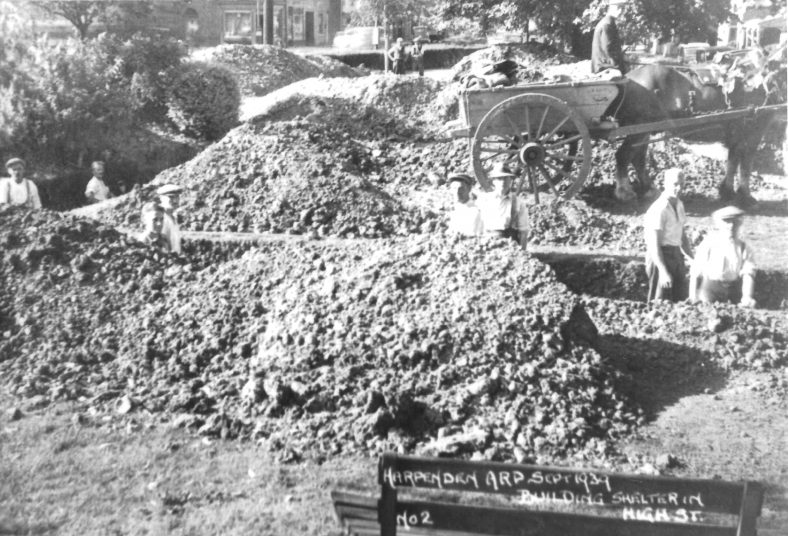
Excavations for the shelter near Bowers Parade, 1939. Credit: LHS archives – LHS 5467
One was located on the site of the village’s former Cock pond – which had been drained and grassed over some eleven years earlier. It remains a green space today, in front of Bowers Parade. Excavation work on that shelter began on August 25 1939, just nine days before Neville Chamberlain officially declared Britain to be at war with Germany.
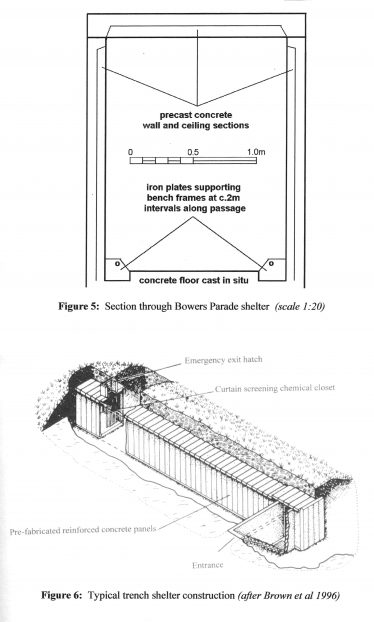
Typical plan of Harpenden shelters. Credit: ASC Report, 2007
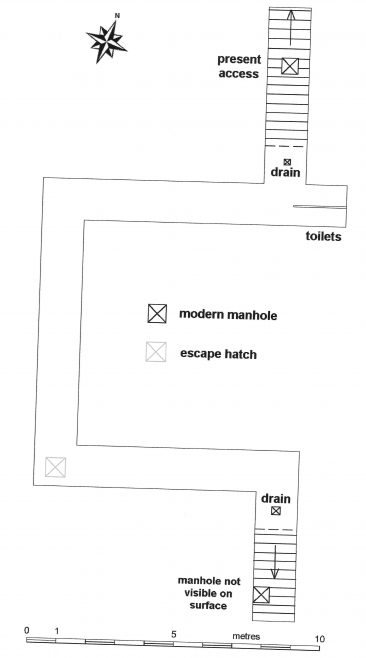
Typical plan of Harpenden shelters. Credit: ASC Report, 2007
Like all subsequent below-ground air raid shelters in Harpenden its construction was on the cut-and-cover principle, using pre-cast reinforced concrete sections for the walls and ‘roof’. Wooden benches along the sides provided rudimentary comfort for ‘shelterers’, who also enjoyed the dubious facility of chemical ‘Elsan’ type toilets, located behind sackcloth modesty screens.
A plan view of the shelter reveals its ‘dog leg’ configuration. Rather than one long ‘tunnel’ like some wartime shelters, it comprises six shorter 10-yard lengths connected by 90 degree corners. It was designed to accommodate up to 180 occupants, sitting on wooden benches along both sides of the ‘tunnel’ sections. Though more likely to induce feelings of claustrophobia in the occupants furthest from the entrance steps, the layout was intended to minimise the effects of blast should an explosion occur in ‘blast range’ of an entrance. There were, in any case, two additional intermediate emergency ‘escape’ hatches accessed via vertical iron ladders. In March 1941, battery lighting was installed in the Bowers Parade shelter.
Two years after the end of hostilities, in October 1947, Harpenden UDC took over responsibility for the shelter, blocking the entrances with manhole covers, at a cost of £30, and for some reason erecting fences around them, the fences remaining in place until the 1960s. In 1983, to further block access, following incidents of youngsters allegedly indulging in ‘glue sniffing’ in the shelter, the manhole covers were barred and padlocked.
Arden Grove – Public Hall car park
A similar pattern of events unfolded during the early part of the war, at four other sites in Harpenden. War preparations brought a halt to plans for a garden on the west side of Arden Grove to be included in the development of the new Public Halls. Instead, below an area of what is today a car park, a subterranean air raid shelter was constructed. Messrs Fowler, a building company, began work in November 1939; the contract was valued at £69 1s 0d. In March 1941, the NorthMet (the electricity supplier serving a large area to the north of London) installed mains power and lighting for the shelter.
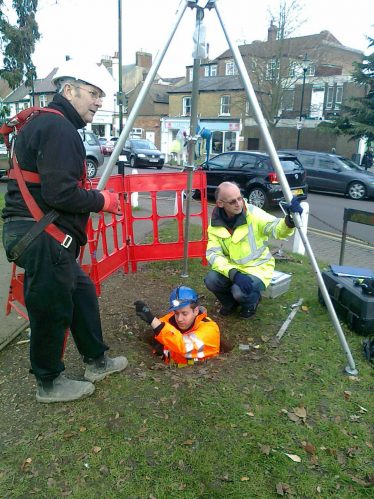
Inspection on Leyton Green, 2013. Credit: Christopher Dean, 2013
A manhole cover was fitted over the Arden Grove shelter entrance by Harpenden UDC in October 1947, but the accompanying gate and fence were not removed until August 1948. The shelter’s air vents can still be seen in what is now the scrappy hedge alongside Arden Grove.
Leyton Green
On the other side of the High Street (then part of the A6 London-Carlisle trunk road) two separate shelters were dug below Leyton Green, identified as Leyton Green north and Leyton Green south. They are of the same ‘three sides of a 10 yards-square’ configuration, each intended to accommodate 100 people, with staircase access at both ends, angled to minimise blast, and a manhole (with ladder) escape hatch at one corner. Both Leyton Green shelters remain there today, though each has only one entry manhole visible.
The Common near Heath Road (now Health Close)
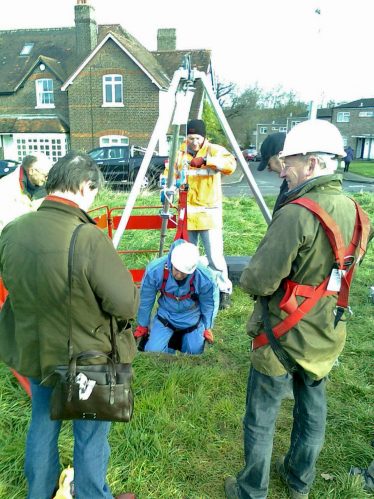
inspecting the Queens Road shelter. Credit: Christopher Dean, 2013
An altogether larger cut-and-cover shelter was built on the edge of the town, below Harpenden Common, adjacent to Queens Road, at a cost of £705. Its stated – though perhaps optimistic – capacity was 400 people, but that must have assumed all the occupants to be standing and uncomfortably close together. Elsewhere the capacity of seated occupants is quoted as 120, though even that figure came down should the shelter be configured with overnight accommodation; the suggestion was 16 bunks plus seating for a further 60.
The Queens Road shelter was laid out in the form of a 10 yard square, accessed via stairs midway along two opposite sides. In December 1940, 16 double sleeping bunks were installed, at a further cost of £30 1s. Problems with rain ingress through the ‘roof’ required the soil covering to be removed and a layer of bitumen applied. Following the end of hostilities in May 1945, the shelter’s mains electric lighting was removed and the entrance blocked, though its surrounding chain-link fence remained for some time afterwards.
Other kinds of shelter
A shelter was proposed at the LMS (Harpenden Central) station in July 1940 but was not built. The emergency control centre underground beside the (old) Fire Station was sometimes referred to as an air raid shelter. It was filled in when the new Town Hall was built.
A ‘tin’ air raid shelter was provided in Crabtree Lane and was re-covered by the Council in 1945. A specimen trench shelter was dug in Stewart Road in 1938 and remained for some months allowing residents to see how to provide their own.
Some residents erected their own Anderson shelters: one or two remained until recently. We would be pleased to borrow and scan any photos showing Anderson shelters in Harpenden gardens, for the Society’s archives.
Inspections
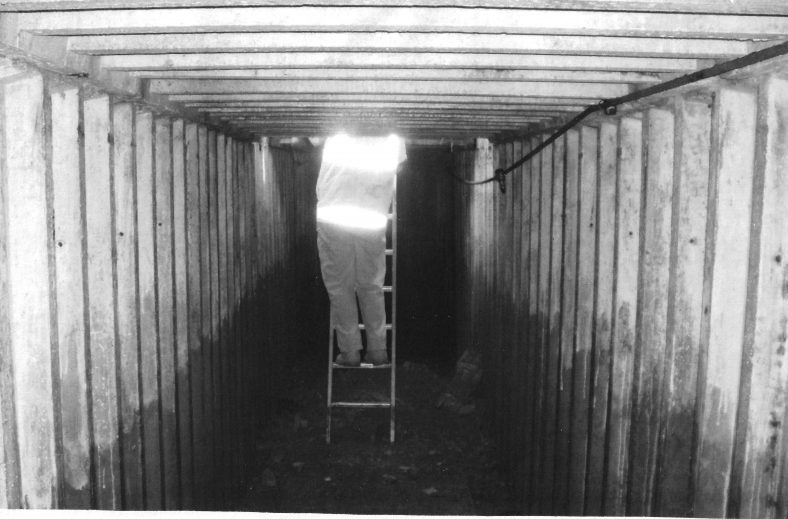
Maintenance work in 2007. Credit: LHS archives – LHS 10317
Safety inspections of all the shelters have been undertaken periodically over the intervening years, the most recent in 2013, reports for which are awaited.
But in 2007 detailed inspections of the Bowers Parade, Leyton Green and Queens Road shelters (though not of the Arden Grove installation) were carried out on behalf of Harpenden Town Council and the inspectors’ findings published, including historical research provided by Geoff Woodward. All the shelters were found in 2007 to be ‘sound and dry’, the only exception being at the Bowers Parade site, where several roof slabs proved to have ‘cracked and sagged’, though remaining in place.

No Comments
Add a comment about this page